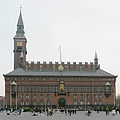Talk:Renaissance Revival architecture
| Renaissance Revival architecture received a peer review by Wikipedia editors, which is now archived. It may contain ideas you can use to improve this article. |
A fact from Renaissance Revival architecture appeared on Wikipedia's Main Page in the Did you know column on 18 April 2006. The text of the entry was as follows:
|
| This It is of interest to the following WikiProjects: | |||||||||||
| |||||||||||
Untitled
[edit]Images free for use:
More pictures of the interior giving perhaps a better sense of the size are available at http://gallery.vegalabs.net under the Poland > Warsaw pictures. --Vegalabs 13:12, 18 April 2006 (UTC)
- Thanks, we will definitly use some, perhpaps drawing some complarissions with the staircase at Chateau de Blois etc. Thanks Giano | talk 16:44, 18 April 2006 (UTC)
Various Neo-Renaissance samples
[edit]-
The Nordic Museum in Stockholm, by Isak Gustaf Clason.
-
The Nordic Museum, as seen from Skansen.
-
The house of Norrlands nation in Uppsala, also by Clason and usually said to be in "Dutch Renaissance".
-
German Neo-Renaissance "porcellaine cupboard", made in Berlin and depicted in Swedish periodical 1871.
-
Many public buildings in Vienna
-
Neo-Mannerist railing detail, The Dakota, New York
-
Wut interior
Renaissance architecture
[edit]This article is trying to cover Renaissance architecture as well, which is making the subject unmanageable, especially now that User:Giano has been so effectively discouraged. This article should be discussing the revival of Renaissance modes, with references to quattrocento or cinquecento models confined to Notes, and small thumbnails used only to contrast with Neo-Renaissance examples. --Wetman 03:59, 22 October 2006 (UTC)
- I've noted your point Wetman and to a certain degree agree with them, the problem is that at the the moment Renaissance architecture is not a very good page, I've spent an hour or so on it this afternoon (daring to move some unsightly templates, expand the text and give ot a more approachable readable (I hope) feel, so that this page can then refer back to it, but I do think that before this page can progress further "Renaissance architecture" has to be vastly improved. Giano 14:57, 22 October 2006 (UTC)
![]() You are invited to join the discussion at Talk:Neo-Renaissance (disambiguation)#Proposal to reformat page. Shhhnotsoloud (talk) 13:19, 21 July 2017 (UTC)
You are invited to join the discussion at Talk:Neo-Renaissance (disambiguation)#Proposal to reformat page. Shhhnotsoloud (talk) 13:19, 21 July 2017 (UTC)
Re: "Gothic Influences on the Renaissance Revival" section
[edit]This point of discussion is especially addressed to User:Giano, as he seems to be the most active and vigilant editor of this article, but naturally any and all who are interested in the aforementioned section, or are more well-versed in its subject than I appear to be, should chime in. A day ago, not under my username however, I replaced in its entirety the section of the article meant to elucidate the role played by Gothic architecture in determining the form taken by architecture designated as Renaissance from the fifteenth and sixteenth centuries and therefore, also, that taken by the revived nineteenth century iteration which is the subject of this article. The brief paragraph, with which I replaced the section, was free of inline citations but as the original was as well, and seemed to consist of observations and analyses which its author thought beyond doubt, readily confirm-able, or common knowledge, I didn't think my replacement required any. The primary assertion of my replacement-paragraph was that while the classicist architecture of the Italian Renaissance, as evidenced by its palazzi, pedimented and domed churches, colonnades, and, among other things, generally symmetrical compositions was as far afield of the Gothic style as the original section claimed, much of the polite architecture beyond the Alps- I'm thinking particularly of England and France- of the 16th century which is called Renaissance- the chateaux of Francois I's reign or the prodigy houses of the Elizabethan period, for example, owe something if not much to pre-Renaissance, medieval aesthetics and modes of building, and that it is in ornament and not massing, construction, or what I would call overall aspect, that these northerly examples exhibit a classicising influence courtesy of Italy. I think the presence of the conical turrets, asymmetrically amassed towers and bartizans, courtyards of which the placement and position is derived from the medieval castle bailey, steeply pitched hip roofs, and occasional single-ply room arrangements so frequently seen in French and English stately residences built in the 16th century clash with the original paragraph's opening statement: "Historically speaking, there were no similarities between Gothic architecture and the succeeding Renaissance architecture." I also intended my paragraph (removed through reversion)- https://en.wikipedia.org/w/index.php?title=Renaissance_Revival_architecture&diff=846356387&oldid=841137015 -to be more clear as well as more accurate- something I think it achieves. I could type on but I'd prefer to wait for responses. Thank you for reading.Mutophilus (talk) 06:44, 19 June 2018 (UTC)

















